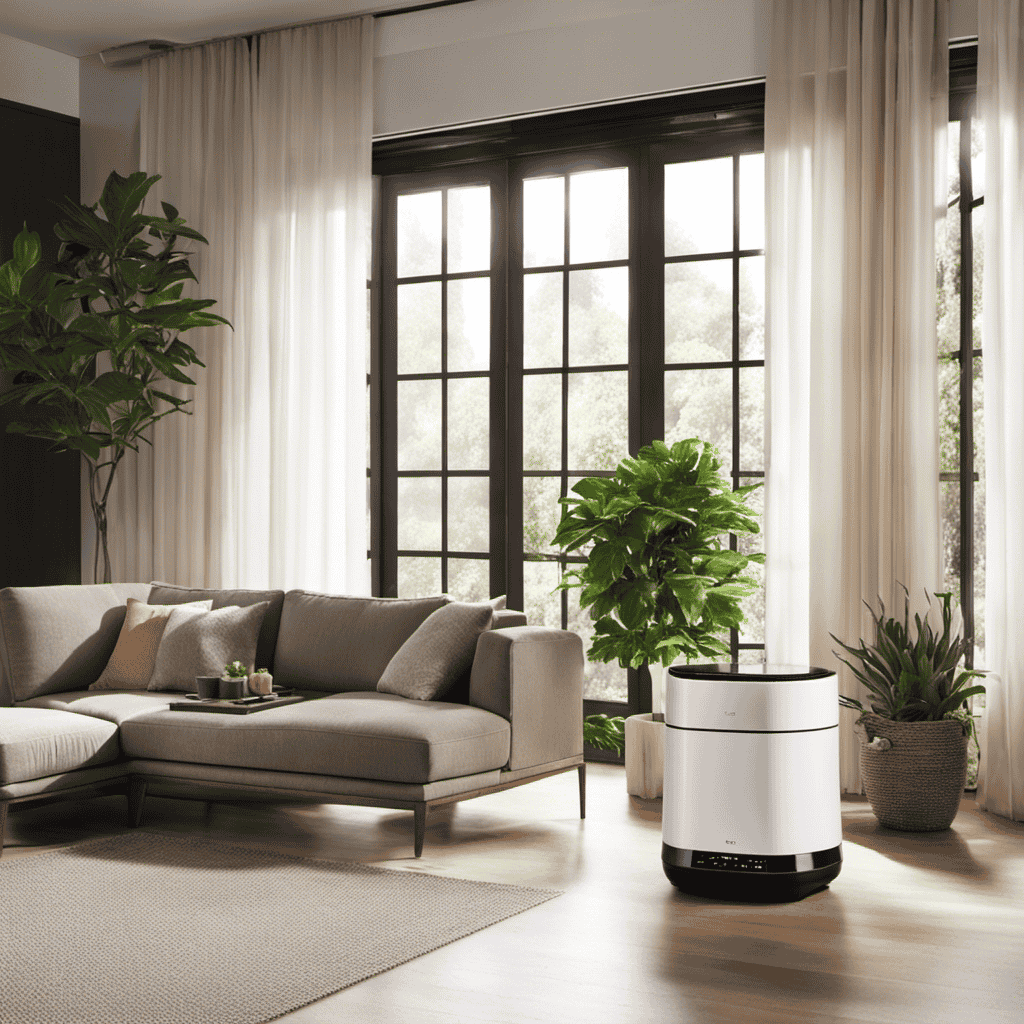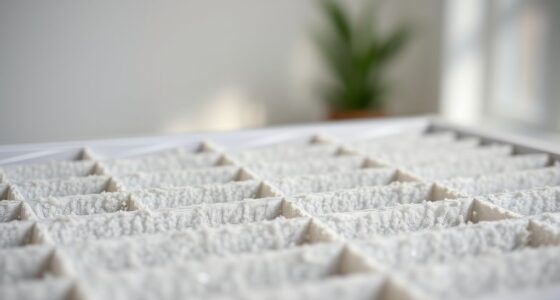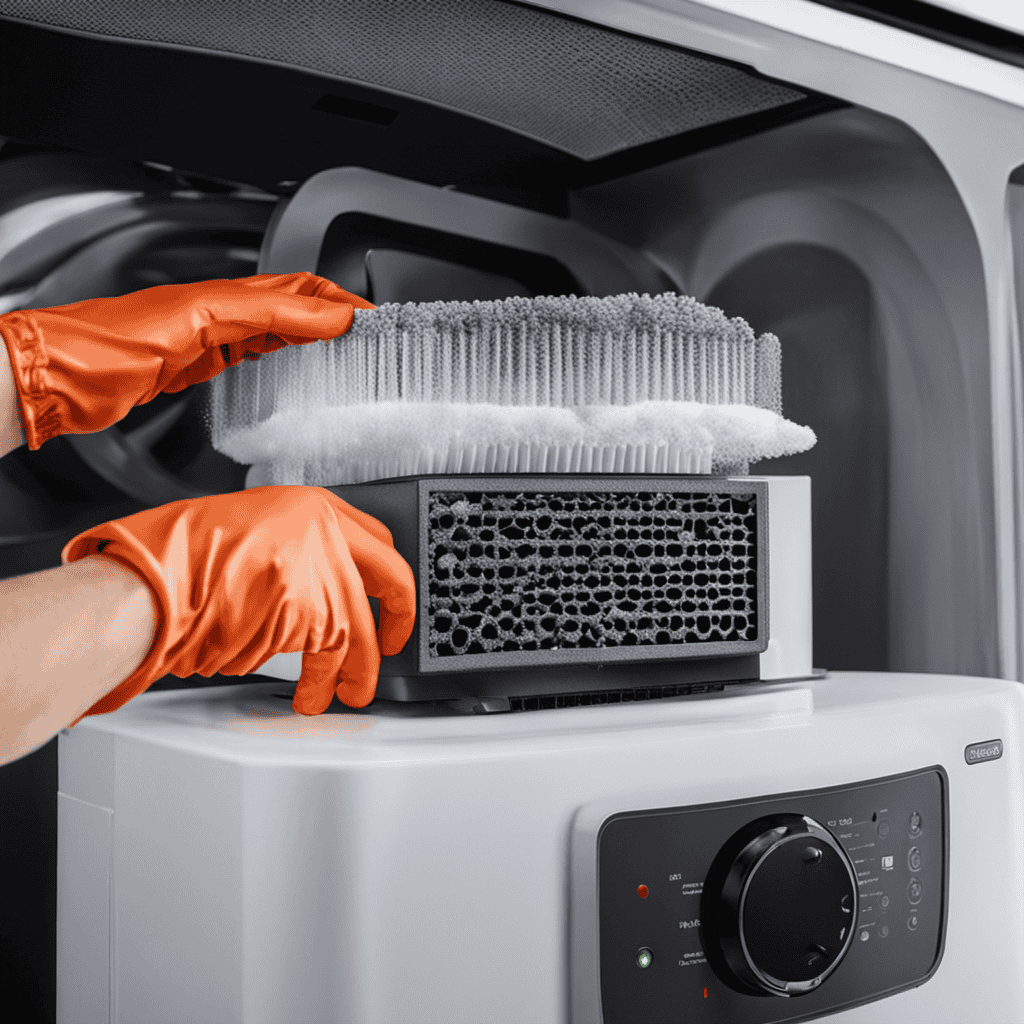As an individual who has dealt with allergies and bad air quality, locating the ideal spot for my air purifier was a top priority. With numerous choices on the market, it can be daunting to decide where to position this essential device.
But fear not, for I have done the research and compiled this comprehensive guide on where to put your air purifier. From the bedroom to the office and even high-traffic areas, I will provide you with the knowledge you need to breathe easy and live a healthier life.
Key Takeaways
- Air purifiers should be placed strategically in different rooms such as bedrooms, living rooms, kitchens, and offices to target specific areas where air quality may be compromised.
- Considerations such as optimal air circulation, space-saving placement, and noise level should be taken into account when deciding where to put an air purifier.
- Placement in specific areas like basements and garages can help improve the air quality in these often neglected spaces.
- The benefits of placing air purifiers include improved air quality, reduction of allergens and odors, prevention of mold growth, and enhanced sleep and comfort.
Bedroom Placement
You should place the air purifier in your bedroom to improve the air quality while you sleep. Optimal placement of the air purifier in the bedroom is crucial for effective filtration.
When deciding where to put your air purifier, consider the size of the room. Larger bedrooms may require a more powerful air purifier to effectively clean the air. Additionally, it is important to place the air purifier in an area where it can circulate the air properly. Avoid placing it near walls or furniture that may obstruct the airflow.
It is also recommended to position the air purifier at a level where it can capture airborne contaminants effectively. By placing the air purifier in your bedroom, you can ensure that you breathe clean and fresh air throughout the night, promoting better sleep and overall well-being.
Now, let’s move on to the next section about living room placement.
Living Room Placement
To maximize effectiveness, it’s important to consider the placement of an air purifier in your living room. Here are some optimal placement and maintenance tips to keep in mind:
- Position the air purifier in a central location within the room to ensure maximum coverage.
- Avoid placing the unit near furniture or walls that may obstruct airflow and reduce its effectiveness.
Regularly clean and replace the filters according to the manufacturer’s instructions to maintain optimal performance.
- Consider the size of the room when selecting an air purifier, as larger rooms may require a more powerful unit.
- Keep the surrounding area clean and free from dust and debris to prevent clogging of the air purifier’s filters.
Kitchen Placement
When considering placement in the kitchen, it’s important to ensure that the air purifier is positioned away from cooking appliances. This is because cooking appliances, such as stoves and ovens, can produce smoke, grease, and other particles that can clog the air purifier’s filters and reduce its effectiveness.
Additionally, cooking appliances can generate heat, which can affect the air purifier’s performance and lifespan. It is recommended to place the air purifier in a central location in the kitchen, away from the cooking area, to ensure optimal air circulation and filtration.
When choosing an air purifier for the kitchen, it is also important to consider the optimal filter size for the room size and the noise level of the purifier, as loud purifiers can be disruptive in a busy kitchen environment.
Office Placement
Positioning the air purifier in an office away from electronics and dust-prone areas can help maintain clean and fresh air quality. As someone who has extensively researched the optimal workplace location for air purifiers, I can confidently say that it is crucial to consider noise level considerations when deciding where to place the device.
Here are five key points to keep in mind:
- Choose a location that is away from high-traffic areas to minimize disturbance caused by the purifier’s noise.
- Avoid placing the purifier near electronics, as they can interfere with its performance and potentially generate additional noise.
- Keep the purifier at a comfortable distance from your work area to ensure maximum air circulation without causing any discomfort.
- Consider placing the device near the entrance or windows to capture pollutants entering the office.
- Regularly clean and maintain the purifier to optimize its effectiveness and reduce noise levels.
Nursery Placement
When it comes to setting up a nursery, there are several key points to consider.
First, finding the optimal location is crucial for the baby’s comfort and safety.
Second, air circulation in the nursery plays a significant role in maintaining a healthy environment.
Lastly, it is essential to take necessary safety precautions to ensure the well-being of the child.
Optimal Nursery Location
The best place to put the air purifier in the nursery is near the crib to ensure clean air for the baby. With the right placement, the air purifier can not only improve air quality but also enhance nursery decor.
Here are some benefits of having an air purifier in the nursery:
-
Reduces allergens: An air purifier can remove common allergens like dust, pollen, and pet dander from the air, providing a healthier environment for the baby.
-
Eliminates odors: Diaper changes and baby messes can sometimes create unpleasant odors, but an air purifier can help eliminate them, keeping the nursery smelling fresh.
-
Filters harmful particles: Air purifiers with HEPA filters can capture tiny particles, including bacteria and viruses, helping to reduce the risk of respiratory infections.
-
Provides white noise: Some air purifiers have a built-in fan that produces a soothing white noise, which can help the baby sleep better.
-
Enhances nursery decor: Many air purifiers come in sleek designs and stylish colors, making them a functional and aesthetically pleasing addition to the nursery.
Air Circulation Considerations
To optimize air circulation in the nursery, it’s important to place the air purifier in an area where it can effectively circulate clean air throughout the room. Air purifiers work by filtering out impurities in the air, such as dust, allergens, and odors. By strategically positioning the air purifier, you can ensure that it effectively removes these impurities from the nursery’s air.
It is recommended to place the air purifier in a central location, preferably elevated, to allow for better air circulation. Additionally, regular maintenance is essential to maximize the air purifier’s effectiveness. This includes cleaning or replacing the filters as recommended by the manufacturer.
By following these maintenance guidelines and positioning the air purifier correctly, you can ensure that your nursery has clean and fresh air.
Now, let’s discuss some safety precautions to consider.
Safety Precautions to Consider
It’s important to consider safety precautions when positioning the nursery air purifier. Here are some key factors to keep in mind:
-
Distance: Place the air purifier at least three feet away from the crib or any other sleeping area to prevent the child from accidentally knocking it over.
-
Electrical safety: Ensure that the purifier is plugged into a grounded outlet and use a surge protector to protect against power surges.
-
Cord management: Keep cords out of reach to prevent the child from pulling on them or tripping over them.
-
Maintenance: Regularly clean and replace filters as recommended by the manufacturer to ensure optimal performance and prevent the accumulation of dust and allergens.
-
Choosing the right size: Consider the size of the nursery when selecting an air purifier. It should have a sufficient coverage area to effectively clean the air in the room.
Basement Placement
For optimal air quality, consider placing your air purifier in the basement. Basements are often more prone to moisture and mold growth due to their underground location. By placing an air purifier in the basement, you can effectively control the humidity levels and prevent mold from spreading. The table below highlights the benefits of basement placement for air purifiers:
| Benefits of Basement Placement |
|---|
| Optimal Humidity Control |
| Effective Mold Prevention |
| Improved Air Quality |
Basements typically have higher humidity levels compared to other areas of the house. This can lead to the growth of mold and mildew, which can cause respiratory issues and allergies. An air purifier in the basement helps maintain optimal humidity levels, reducing the risk of mold growth. Additionally, the air purifier filters out airborne particles and allergens, improving the overall air quality in your home.
Garage Placement
Placing an air purifier in the garage can help improve the air quality in that space. Here are five reasons why garage ventilation and air quality are important:
-
Garages often contain pollutants such as car exhaust fumes, chemicals from stored items, and dust particles.
-
Poor garage ventilation can lead to a buildup of harmful gases and odors, which can be detrimental to your health.
-
An air purifier can filter out these pollutants, removing harmful particles and improving the overall air quality in the garage.
-
Breathing clean air in the garage can prevent respiratory issues and allergies.
-
Improved garage air quality can also reduce the risk of indoor air pollution spreading into the rest of the house.
By considering these factors, you can make an informed decision about placing an air purifier in your garage to ensure a healthier living environment.
Now, let’s explore the benefits of placing an air purifier in the dining room.
Dining Room Placement
Having an air purifier in the dining room can significantly improve the quality of the air I breathe during meals. Optimal air filtration is crucial in this space, as it helps remove airborne pollutants such as dust, allergens, and cooking odors that can affect the overall dining experience.
Research shows that air purifiers with HEPA filters are the most effective at capturing small particles, providing cleaner air for me to breathe.
When considering the placement of an air purifier in the dining room, aesthetic considerations also come into play. It is important to choose a purifier that blends seamlessly with the room’s decor and does not disrupt the overall ambiance.
Bathroom Placement
When considering the placement of an air purifier in your bathroom, it’s important to choose a location that allows for optimal air circulation and filtration. The bathroom is a space where moisture and odors tend to accumulate, making it a prime area for mold growth. By placing an air purifier in your bathroom, you can help maintain optimal humidity levels and prevent the growth of mold.
Here are some factors to consider when placing an air purifier in your bathroom:
- Choose a location away from direct water sources to prevent damage to the unit.
- Position the purifier near the toilet or shower to capture odors and airborne particles.
- Ensure that there is sufficient space around the purifier for proper air flow.
- Consider a portable air purifier that can be easily moved around for targeted filtration.
- Regularly clean and maintain the air purifier to ensure optimal performance.
Pet Area Placement
If you have pets, it’s important to choose a location for their designated area that allows for easy cleaning and maintenance. When deciding on the optimal pet location, there are several pet-specific considerations to keep in mind. Firstly, it’s important to choose a spot that is easily accessible for your pet. Consider their size and mobility when selecting the area. Additionally, the location should be away from high traffic areas to give your pet a sense of privacy and security. Secondly, think about the type of flooring in that area. Hardwood or tile floors are easier to clean and maintain than carpet, especially in case of accidents. Lastly, ensure that the location has proper ventilation and is well-lit to promote a healthy and comfortable environment for your furry friend.
| Pet-Specific Considerations | Optimal Pet Location |
|---|---|
| Accessibility | Away from high traffic areas |
| Flooring | Hardwood or tile |
| Ventilation and Lighting | Proper ventilation and well-lit area |
Allergy-Sensitive Room Placement
An ideal location for an allergy-sensitive room is one that is away from high traffic areas and has proper ventilation and lighting. This helps minimize the exposure to allergens and creates a comfortable environment for individuals with allergies.
When considering the placement of an air purifier in an allergy-sensitive room, there are several factors to keep in mind:
-
Optimal filter size: Choosing an air purifier with a filter size appropriate for the room’s square footage ensures effective removal of allergens.
-
Noise level considerations: Selecting an air purifier with a noise level that is tolerable for the room’s occupants is essential for a peaceful and undisturbed environment.
By considering these factors, one can create an allergy-sensitive room that promotes clean air and improves overall comfort.
Now, let’s explore the placement of air purifiers in high-traffic areas.
High-Traffic Area Placement
To effectively address high-traffic areas, you’ll want to consider alternative methods of improving air quality. One important factor to consider is the size of the air purifier. For high-traffic areas, it’s recommended to choose a larger air purifier that can handle the increased volume of pollutants. This will ensure that the air is effectively cleaned and filtered.
Additionally, it’s crucial to establish a regular cleaning schedule for the air purifier in these areas. High-traffic areas tend to accumulate more dust and debris, which can affect the performance of the device. By regularly cleaning and maintaining the air purifier, you can ensure that it continues to effectively clean the air in these busy areas.
Transitioning into the subsequent section about multi-level home placement, it’s important to consider the specific needs of each level in order to optimize air purification throughout the entire home.
Multi-Level Home Placement
When considering placement in a multi-level home, it’s important to evaluate the specific air purification needs of each level. Proper placement of air purifiers can ensure optimal air quality throughout the entire home.
Here are some key factors to consider for multi-level home air purifier placement:
-
Staircase air purifier placement: Placing an air purifier near the staircase can help capture airborne pollutants that may travel between different levels of the home.
-
Centralized placement: Positioning air purifiers in central areas of each level can help distribute purified air more evenly.
-
High-traffic areas: Placing air purifiers in high-traffic areas, such as living rooms or bedrooms, can help filter out pollutants brought in by foot traffic.
-
Bedrooms: Having air purifiers in bedrooms is essential for creating a clean and healthy sleeping environment.
-
Basement and upper levels: These areas often have unique air quality concerns, such as dampness or heat, so consider placing air purifiers strategically to address specific issues.
Small Apartment Placement
When it comes to placing an air purifier in a small apartment, there are two key considerations: optimal air circulation and space-saving placement.
To ensure optimal air circulation, it is important to place the air purifier in a central location where the air can flow freely throughout the entire space.
Additionally, due to limited space in small apartments, it is crucial to find a compact air purifier that can be easily placed on a countertop or mounted on a wall to save valuable floor space.
Optimal Air Circulation
Proper air circulation is key for optimal performance of your air purifier. Without good air circulation, the air purifier may struggle to effectively filter the air in your space.
Here are some important things to consider for air purifier maintenance and the benefits of good air circulation:
- Clean and replace filters regularly to ensure efficient airflow and maximum filtration.
- Keep the surrounding area clear of obstructions to allow air to flow freely into the purifier.
- Position the air purifier at least a few feet away from walls and furniture to prevent blockage.
- Avoid placing the air purifier in areas with high humidity, as it can affect its performance.
- Consider using a fan to help distribute purified air throughout the room.
With proper air circulation, your air purifier can effectively remove pollutants and allergens, improving the air quality in your home.
Transitioning into the next section about space-saving placement, let’s explore how to maximize the efficiency of your air purifier while saving space.
Space-Saving Placement
To save space and maximize efficiency, you can position the air purifier a few feet away from walls and furniture. This allows for optimal air circulation and ensures that the purifier can effectively remove pollutants from the room. There are several space-saving solutions and portable options available that make it easy to find the perfect spot for your air purifier. Here is a table showcasing some of these options:
| Option | Description |
|---|---|
| Wall-mounted | Hangs on the wall, freeing up floor space |
| Tabletop | Compact and portable, perfect for small rooms |
| Tower | Slim design that can fit in tight spaces |
These options provide flexibility and convenience, allowing you to place the air purifier wherever it is most needed. In the next section, we will explore the placement of air purifiers in large open spaces.
Large Open Space Placement
If you have a large open space, you should consider placing the air purifier in the center for optimal air circulation. This placement ensures that the purified air is evenly distributed throughout the area, providing clean and fresh air to everyone present.
Here are some key points to keep in mind when considering the placement of an air purifier in a large open space:
-
Large event placement: An air purifier is essential for maintaining good air quality during large events, such as conferences or weddings. Placing it in the center ensures that all attendees can breathe clean air, reducing the risk of allergies or respiratory issues.
-
Outdoor placement: If the large open space is outdoors, it is crucial to choose an air purifier specifically designed for outdoor use. These purifiers are weather-resistant and can effectively filter pollutants from the surrounding air.
-
Consider the size: Make sure to select an air purifier that is suitable for the size of the open space. A larger area may require multiple purifiers or a more powerful unit to effectively clean the air.
-
Accessibility: Place the air purifier in a location that is easily accessible for maintenance and filter replacements. This ensures that the purifier can be properly maintained and continues to function optimally.
-
Noise level: Consider the noise level of the air purifier, especially in a large open space where people may be conversing or engaging in activities. Look for models with low noise levels to avoid any disruption.
What are the Best Placements for an Air Purifier in a Room?
When considering the proper placement of an air purifier in a room, it’s important to first identify the area with the most traffic and potential pollutants. Placing the air purifier in central locations, away from walls and furniture, allows for optimal air circulation and maximum efficiency.
Frequently Asked Questions
Can I Place an Air Purifier in a Multi-Level Home and Expect It to Effectively Clean the Air Throughout All Floors?
Yes, placing an air purifier in a multi-level home can effectively clean the air throughout all floors. The effectiveness of air purifiers in multi-level homes depends on the size and power of the purifier.
What Is the Best Placement for an Air Purifier in a Small Apartment With Limited Space?
In a small apartment with limited space, the best placement for an air purifier depends on the layout and the size of the rooms. Considering the best air purifier brands and how to choose the right one for your apartment is crucial.
Is It Necessary to Have Multiple Air Purifiers in a Large Open Space, or Can One Unit Suffice?
One unit can be effective in a large open space, but multiple units may provide better coverage. Research suggests that strategic placement is key, ensuring proper airflow and targeting areas of high pollutant concentration.
Can an Air Purifier Be Placed in a High-Traffic Area and Still Effectively Clean the Air?
Placing an air purifier in a high-traffic area can effectively clean the air, but it’s also beneficial to have one in bedrooms. Research shows that air purifiers in bedrooms promote better sleep and reduce allergens.
Should I Place an Air Purifier in a Dining Room, or Is It Better Suited for Other Areas of the House?
I find that placing an air purifier in the dining room may not be the best option. Air purifiers are more beneficial in bedrooms, where they can improve sleep quality and reduce allergies and asthma symptoms.
Conclusion
After extensively researching and considering various factors, it is clear that the placement of an air purifier depends on the specific needs and layout of your living space.
Whether it’s the bedroom, living room, kitchen, office, nursery, high-traffic area, multi-level home, small apartment, or large open space, each location has its own unique requirements.
While it may seem ironic that an air purifier, designed to improve air quality, requires careful placement, it is crucial to maximize its effectiveness.
So, choose wisely and breathe in the irony of optimizing your air purifier’s performance.










